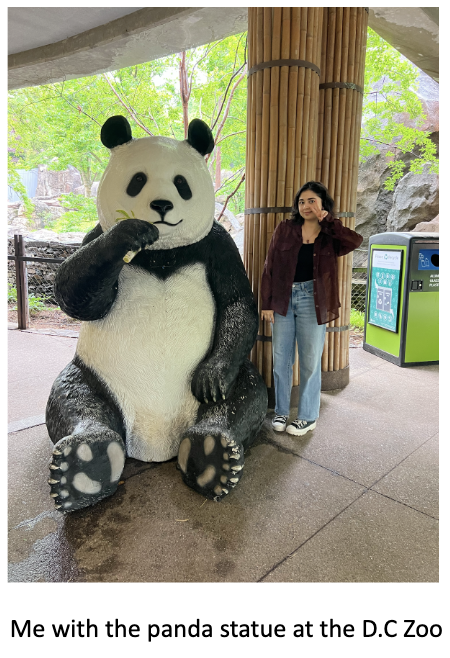Event name: Smithsonian National Zoological Park
Event time and place: from 9am to 2pm at DC
The Zoo has grouped some collections of animals (often some of their smaller ones) in a single thematic building. Some of these buildings are organized by a particular group of animals, sometimes by region or habitat, or sometimes by another theme. Choose two (2) of the following buildings and explore them: Amazonia, Reptile Discovery Center, Small Mammal House, or the newly-reopened Bird House (for the latter you will need to get a free timed entry digital pass; there are QR codes posted around the park to help with this). One of these halls has to be a guided tour of a hall by one of the SGC faculty. Currently we plan our tours for 1 pm: We choose Dr. Merck at Amazonia
For each, identify the one you chose. Describe: · What information is listed for each species · List at least four (4) species that are on display At the Zoo, I observed four unique species: corals, electric eels, caecilians, and Asian elephants. The Coral Lab in the Amazonia Science Gallery showcased different coral species and explained their ecological importance and vulnerability to climate change. The Electric Fishes Demonstration Lab featured a 5-foot-long electric eel(even if it wasn't physically there) capable of producing 800 volts, with interactive displays that showed how it uses electricity to hunt and navigate. In the Amazonia exhibit, I also saw aquatic caecilians—limbless amphibians with reduced vision that rely on other senses to survive in the Amazon River Basin. Lastly, at the Elephant Trails exhibit, I observed a herd of Asian elephants and learned about their behavior, social structures, and the conservation efforts underway to protect them. Also, each exhibit contained the species’ names, habitats, diets, behaviors, and conservation status, which was helpful to learn about. If any, what types of displays that go beyond simple identifying text on a panel are available in this building? (These might be interactive displays, videos, skeletons, or others.) Did you find them to be informative? (These interactives are not necessarily at the four species’ displays.) At the National Zoo, the panda display includes videos and panels that explain how pandas eat bamboo and move. The anatomy video shows their bones and muscles in action, making it easy to understand. Nearby panels and videos give more fun facts about pandas. In the Bird House, some panels are simple and aimed at kids or visitors who may not know much about animals. Overall, these displays are made to be easy to follow, and the moving videos catch more attention than plain signs.
EDUCATION Additionally, zoos are major centers for education about zoological and ecological issues. Find and describe two (2) specific examples of ways that the Zoo aids in the public understanding of animals and ecosystems OTHER THAN simple plaques with printed information. In addition to plaques, the National Zoo uses interactive methods to teach visitors about animals and ecosystems. One example is the panda exhibit, which includes videos showing pandas in their natural habitat and animations of their anatomy. These help visitors understand how pandas live and function beyond just reading facts. Another example is the children’s area, which features hands-on activities like puzzles, touchscreens, and interactive games that teach about animal behaviors, habitats, and conservation in a fun and engaging way. These tools make learning more accessible and memorable for all ages.
ANIMAL MENTAL/EMOTIONAL WELFARE Let’s face it: zoo animals are kept in captivity, and for many animals this is a potentially traumatic experience. These animals evolved in the wild, and their behaviors are adapted to living in the more complex (and simply BIGGER) world outside. In the old days the mental or emotional welfare of the exhibit animals weren’t of primary concern: just stick them in a cage for all to see. But this attitude has changed. Find at least two (2) specific examples where either the physical setting or objects in their environment have been added to provide a more interesting or comfortable place for the animals. At the Smithsonian’s National Zoo, special features have been added to make animals feel more comfortable and behave naturally. In the giant panda area, there are climbing structures, rope toys, and water pools that let the pandas play, climb, and explore just like they would in the wild. In the Bird House, zookeepers add materials like hay and shavings and place nest boxes among grass and rocks so birds can build nests and lay eggs. These changes help the animals feel at home and give visitors a better look at how they live in nature.


